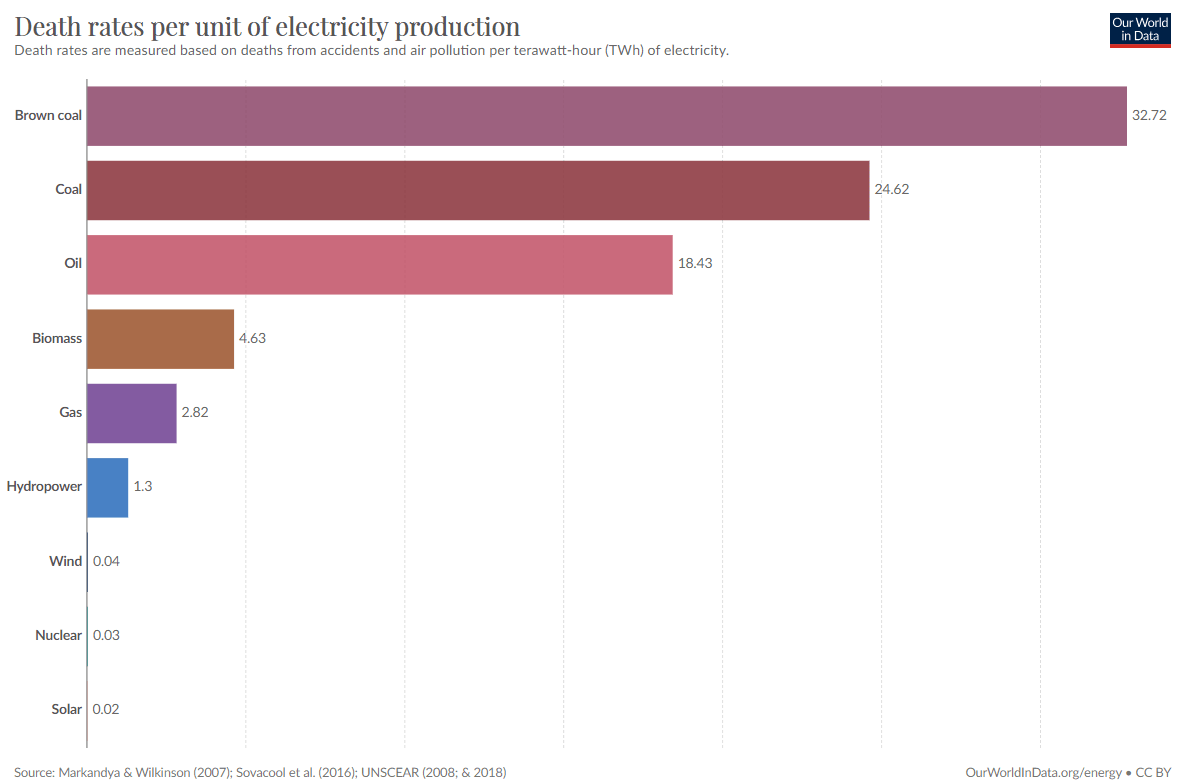Nuclear Energy - Good but not the silver bullet we were hoping for
post by Marius Hobbhahn (marius-hobbhahn) · 2022-04-30T15:41:25.983Z · LW · GW · 33 commentsContents
Executive summary: Practical implications: The basic case for nuclear How safe is nuclear? The waste problem The economics of Nuclear 1. No (more) economies of scale 2. Overregulation 3. It’s just that expensive Future nuclear technologies The role of nuclear in a grid dominated by renewables Plausible futures Invest in nuclear, reform and innovate Invest in renewables and storage Conclusions One last note None 33 comments
This article was written by Samuel Scheuer and Marius Hobbhahn (equal contribution). It was crossposted from Marius' personal blog.
Nuclear power is a very polarized issue. Proponents think it is a clean solution to most of our energy problems and opponents think it is too dangerous or too expensive. In this post, we want to take a deeper look at the case for and against nuclear while trying to be as unbiased as possible.
Executive summary:
Disclaimer: Samuel does an MSc in Environmental Change and Management at Oxford but has no special focus on nuclear energy. Marius has no expertise in nuclear energy and just likes to dig deep into topics. There is a chance we might have misunderstood important details. You should think of the following as our best guess after spending a collective ~50 hours on it. Both of us were proponents of nuclear before doing this research but we are now considerably less convinced of its value.
Answering questions about nuclear power is more complicated than we assumed. However, there are a couple of things we can say with high confidence.
- Nuclear power is a carbon-neutral, stable source of energy that gives you high independence from other countries and conflicts.
- Nuclear power is likely very safe and creates way less harm than e.g. a coal power plant of similar size.
- The nuclear waste problem is likely neither very big nor very expensive.
- On average nuclear energy is more expensive than renewables (~2x) and we can expect this gap to widen in the future.
On the other hand, there are a couple of other questions that carry more uncertainty.
- Some people argue that nuclear energy regulation is unreasonably stringent and thus prevents innovation and inflates prices. The majority of reports (pro- and anti- nuclear) don’t mention overregulation as a major problem. We think the narrative is plausible because of misaligned regulatory incentive structures but we aren’t very confident.
- The “true cost” of nuclear energy is hard to determine because it depends on specific timelines (e.g. waste management) and discount factors. Therefore, all arguments around “nuclear is cheap/expensive” carry considerable uncertainty. Our best guess is that nuclear is and will stay on the more expensive side of energy production.
- There are many people who claim that “nuclear just needs more innovation/research”. However, governments have invested large amounts of money into nuclear energy research over the last 70 years and progress has remained slow and produced underwhelming results. There is a chance we just haven’t found the breakthrough yet but we think that is unlikely---especially when the alternative is renewable energy which has shown insane speeds of progress (see below). We speculate that this stems from systemic factors, e.g. because nuclear doesn’t profit from economies of scale as much as renewables do.
- The role of nuclear in a world dominated by renewables is unclear. Nuclear takes long to ramp up and is only profitable with high uptime. Therefore, it is not very compatible with the high volatility of renewables--at least in its current form.
- Framing: In general, we find it useful to think of nuclear energy has a high-risk, high-reward investment. There is a small chance we can get the price down significantly and then nuclear will be god-tier and there is a large chance it will always be too expensive.
Practical implications:
- It does NOT make any sense to close existing nuclear power plants unless you can guarantee that their energy will be replaced by 100% renewables and storage+distribution has been sorted out.
- Nuclear is nearly always better than fossil fuels. It creates way fewer health problems and GHG emissions. However, it needs more time to ramp up a nuclear reactor than to turn a gas burner on and off. Therefore, nuclear is mostly useful for baseload energy production and not to offset fluctuations in renewables.
- We think there are two possible pathways forward
- Do nuclear but the right way: reform nuclear regulations to allow for more innovation, build explicit testing hubs where it is possible to do research into new reactor designs with relative ease, build smaller reactors that follow a standard design to use economies of scale, and do more research on how to integrate nuclear into a grid dominated by renewables.
- Double down on renewables and storage: The price of solar power and batteries has dropped exponentially while their installed capacity has increased exponentially (see figure below). Doubling down would mean investing in large stationary batteries or hydrogen for storage, investing in better electrical grids to balance the consumption-production-asymmetries, and so forth.
These two paths are, of course, not entirely mutually exclusive, but if we had to design a budget right now, we would put much more resources towards renewables and storage than nuclear after doing this research.
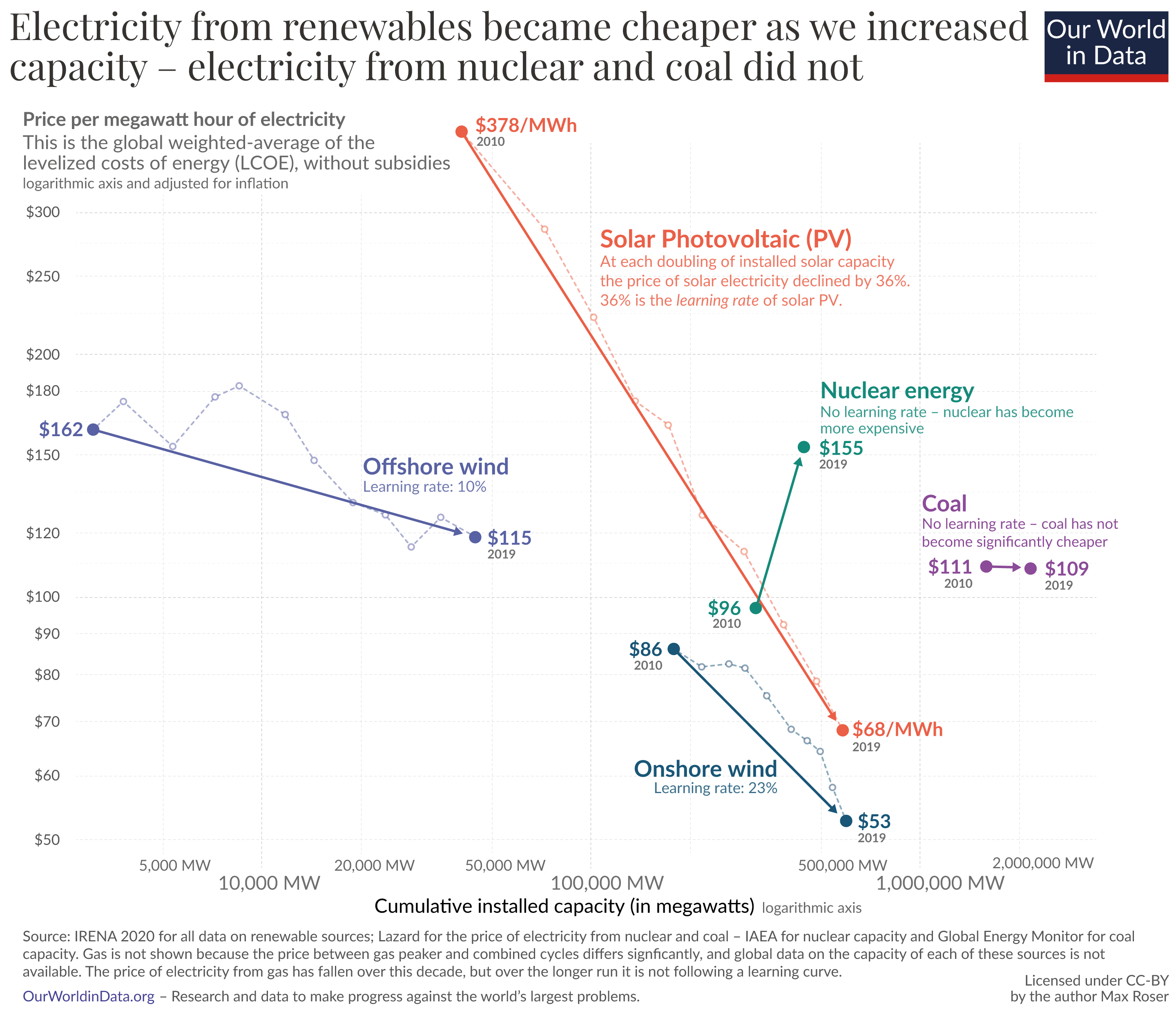
The basic case for nuclear
Before we get into the nitty-gritty details, let’s revisit the basic case for nuclear.
First of all, it’s clean energy. During deployment, nuclear power plants produce no greenhouse gas (GHG) emissions. The implicit GHG emissions from building the plant or the preparation of uranium are relatively small.
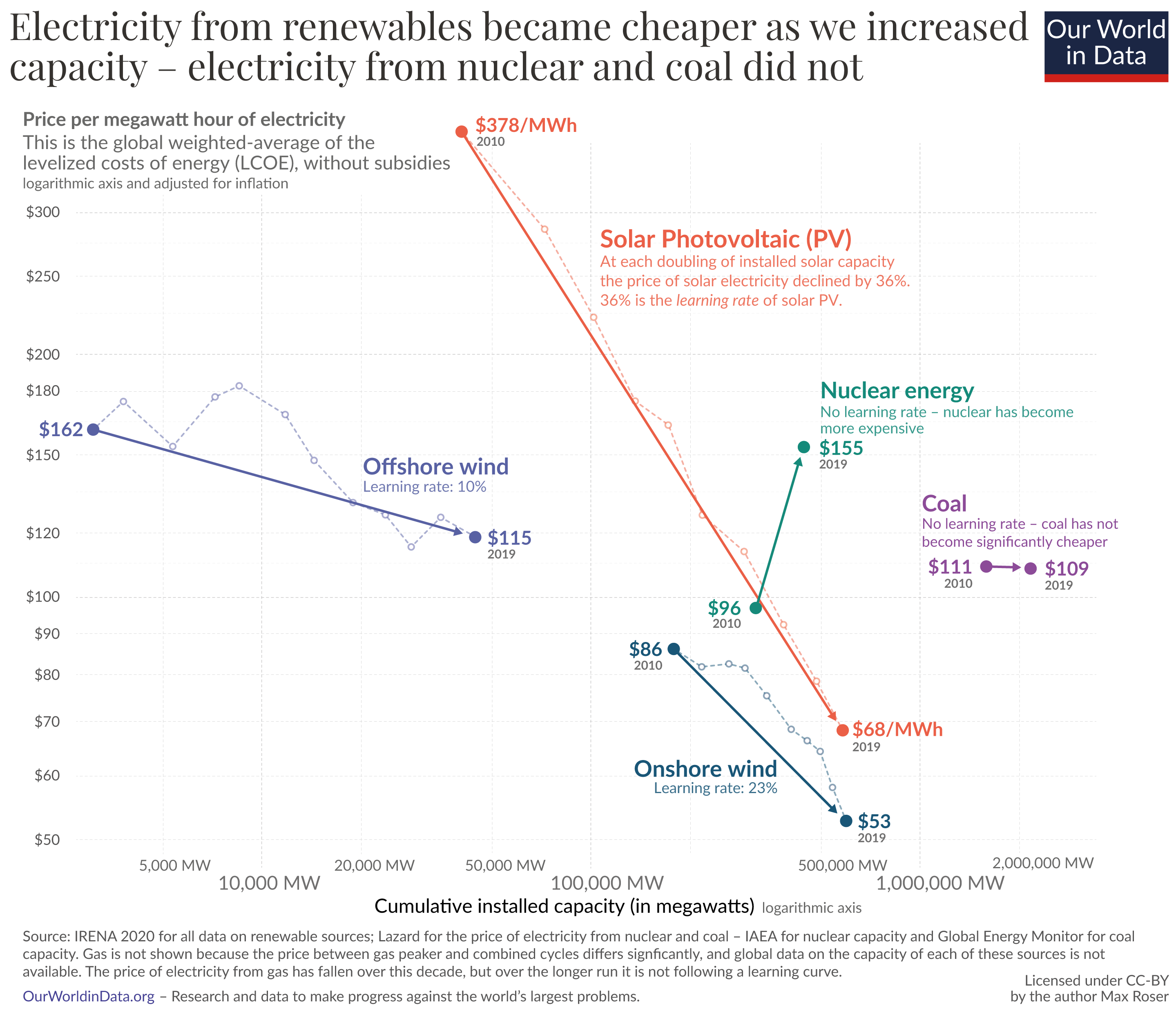
Secondly, nuclear power is a stable baseload, i.e. it is independent of wind, sun and other circumstances. It takes about 12 hours to ramp up a nuclear power plant and it requires high uptime to be economically feasible. This might make it unfit to counterbalance the rapidly changing energy production of renewables (details in later section).
Thirdly, nuclear power gives you energy independence. This became very clear during Russia’s invasion of Ukraine. France, for example, had much fewer problems cutting ties with Russia than e.g. Germany. While countries might still have to import Uranium, the global supplies are distributed more evenly than with fossil fuels, thereby decreasing geopolitical relevance. Uranium can be found nearly everywhere.
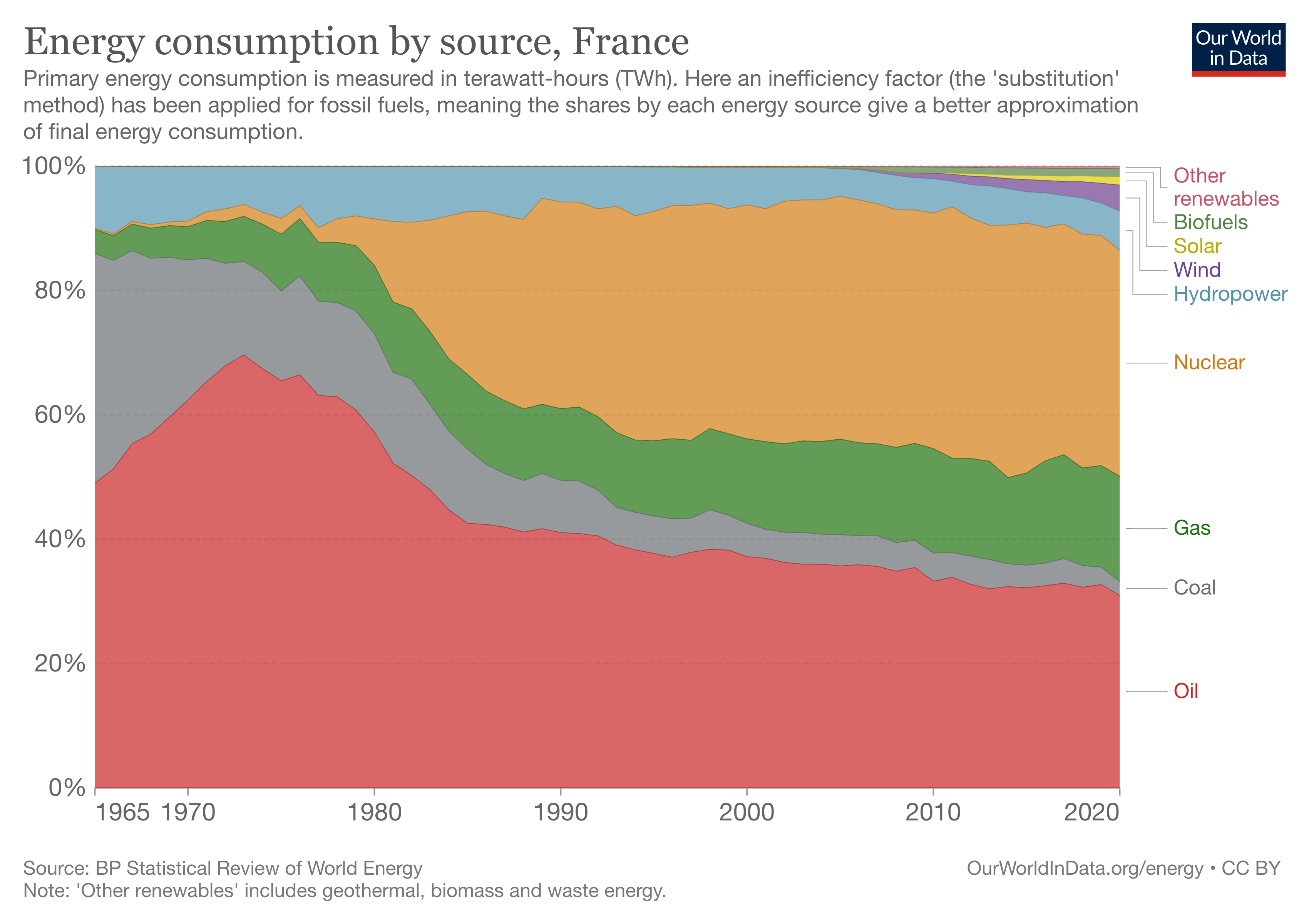
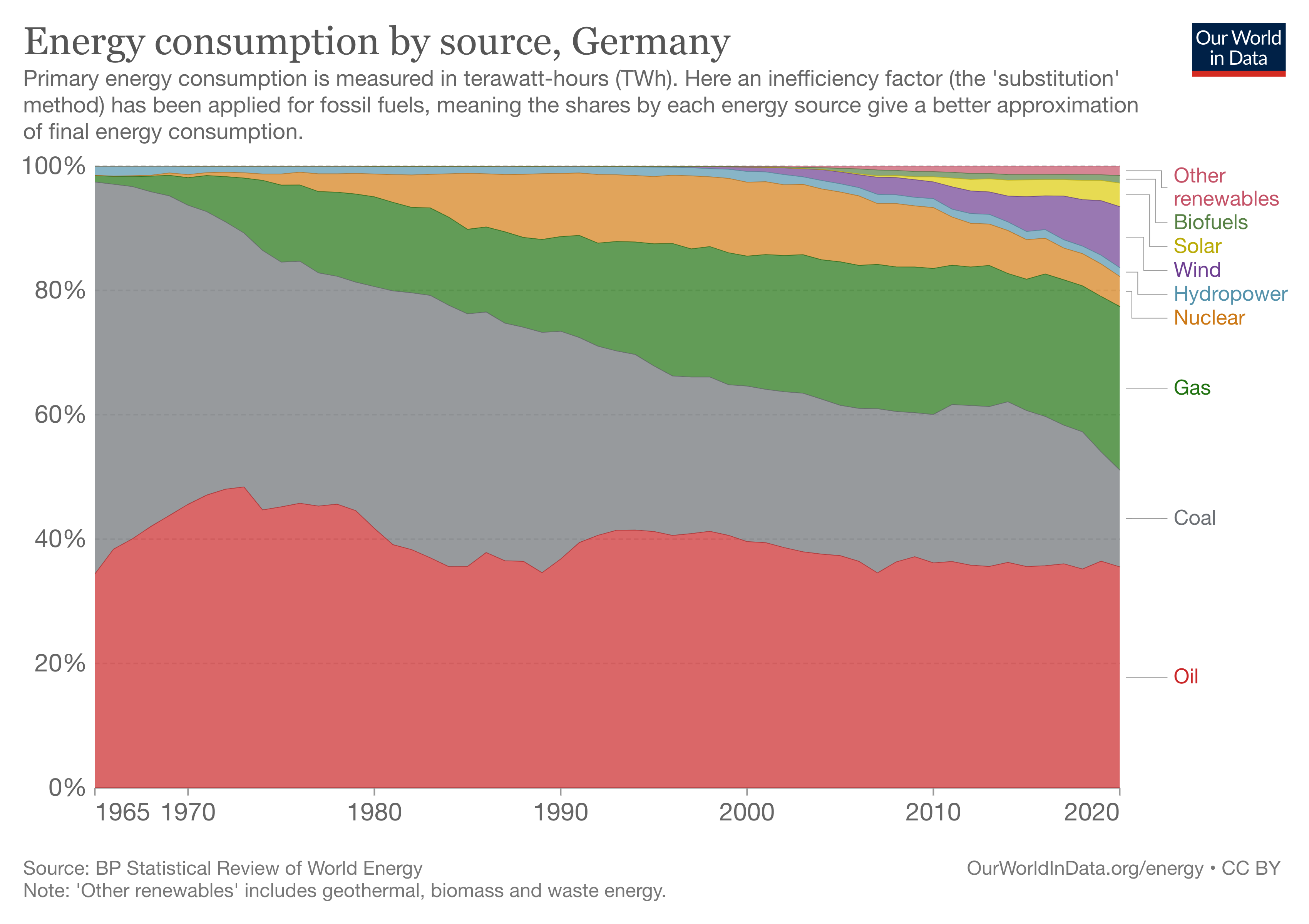
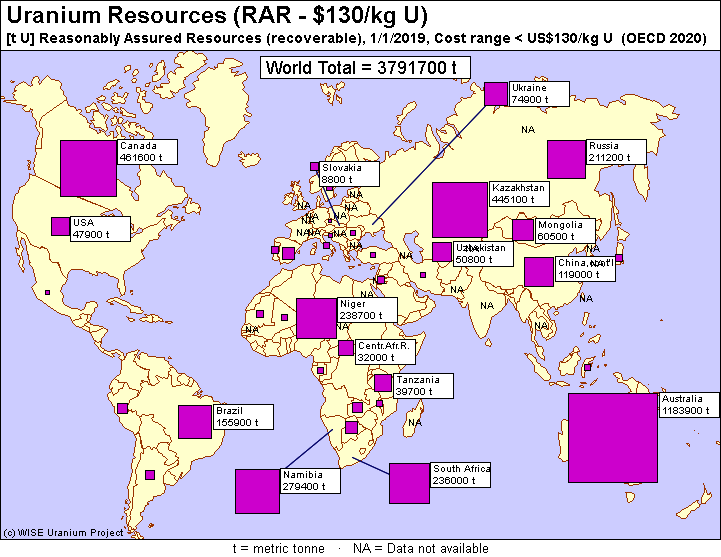
How safe is nuclear?
One of the most common concerns with nuclear energy is safety. People often cite the incidents in Chernobyl and Fukushima as prime examples. However, in Chernobyl (which was the worst incident so far) only 28 people died directly and up to 4000 further deaths are linked to the disaster. In Fukushima, only 3 people died. If you sum up all casualties even including mining and milling, the death toll of nuclear is 1230 times lower than for coal and 263 times lower than for oil (see Our World in Data for more).
The large death toll of coal and oil comes from air pollution which is much more deadly than conventionally assumed. In 2019 alone, 95000 infant deaths could be attributed to air pollution in South East Asia alone (see state of global air report). The annual death toll from fossil fuels is estimated to be 8 million. The Open Philanthropy Project has collected further estimates on the damage of air pollution in this report.
There are also more indirect, fuzzy safety concerns with nuclear, e.g. health effects on people living close to the plant or groundwater contamination from waste. According to this summary, the radiation exposure of workers in nuclear plants and miners in uranium mines is between 1.5 and 2.5 millisieverts per year (mSv/yr) while an average citizen is exposed to about 2.4 mSv/yr of background radiation, i.e. broadly the same amount of radiation. The lowest level at which cancer rates are increased is 100 mSv/yr, i.e. much larger than what anyone is usually exposed to. Long-term storage of high-level nuclear waste is (supposed to be) done in deep geological repositories which are regarded as very safe (see below) thus not increasing radiation risk.
There are some people (see e.g. this post) who claim that most radiation standards are based on outdated methodology and thus put an unreasonably high standard on nuclear radiation when compared to literally any other health standard. While we can’t tell what the correct level of allowed radiation should be, we understand where this view is coming from. The regulatory standards for nuclear are much higher than they are for coal, gas, oil, food or medicine. Whether this is good or bad depends on your perspective, but safety regulations in nuclear energy could probably be drastically lower and wouldn’t increase harm in any meaningful way.
Our overall impression is that nuclear energy is very safe, especially when compared to fossil fuel alternatives. Most nuclear power plants have passive built-in safety mechanisms, e.g. such that cooling systems don’t break when they lose power or the chain reaction in the reactor is stopped automatically.
Furthermore, even the worst-case scenarios seem less problematic than commonly assumed. Contrary to portrayals in pop culture, nuclear power plants don’t explode like an atomic bomb. Usually, they get really hot and possibly melt down. Under specific circumstances, there can be hydrogen explosions that release some amount of toxic material. In cases of old technology and severe human error, they can make the surrounding area uninhabitable. However, this process is so slow and well-monitored that everyone can be safely evacuated in time and no human casualties occur. There are, of course, human and economic costs if an area becomes uninhabitable but the probability of such an event is extremely low. Furthermore, for the extraction of coal, the relocation of entire villages and the destruction of the environment is the norm rather than the exception.
To put it more bluntly--living next to a nuclear power plant or waste storage (especially in the West) is probably orders of magnitude less risky than driving a car and significantly better for your health than living close to a coal plant.
The waste problem
There are a lot of common concerns with waste---most prominently feasibility and cost.
Over 90% of nuclear fuel waste is low-level waste that poses little to no health risk to humans. Only 3% of the waste is classified as high-level waste. It contains 95% of the total radioactivity and thus has to be stored safely. The high-level waste is treated and transported to the final storage facility. It is (or at least supposed to be) stored in deep geological repositories (see also Wikipedia). Those are far below the surface where groundwater is devoid of oxygen which reduces the risk of contamination. Furthermore, the groundwater is additionally monitored by agencies and thus harm to humans is very unlikely. Sweden, for example, has started to build a new storage facility that they regard as a completely safe final repository after collaborating with scientists for multiple decades.
The overall cost of treating, transporting and storing waste seems surprisingly low. This overview claims that waste contributes about 5% of the total cost. This OECD report states that during deployment the entire fuel cycle (upstream and downstream) makes up a maximum of 20% of the cost. A further maximum of 15% of the total cost is used for the decommissioning process---a part of which is long-term storage.
It is important to state though, that all waste costs are supposed to be internalized, i.e. the consumer pays for them already when buying electricity. A part of the profit is then put into a fund that continuously finances the long-term storage of waste. This means that the “waste is too expensive” argument can only hold if there was a serious miscalculation of the waste cost---otherwise, you have already paid for it. If the external costs of fossil fuels would be internalized, their prices would likely increase dramatically. However, for some reason, society decided that only nuclear energy deserves this special privilege.
Unfortunately, the real world is much messier---at least in some countries. In Germany, for example, there is a very strong opposition to waste storage which makes it hard to find a suitable location. Ultimately, we think that problems like this will make waste storage more expensive, e.g. because Germany has to pay Finland for disposal. But it’s not an argument against nuclear per se since we have good and working solutions that just need to be implemented correctly.
We want to mention that opponents of nuclear would tell you that the calculations for long-term storage are misguided and thus underestimate the true cost. Therefore, future generations will pay additional money to fix problems created by us. They argue that a) governments often pay for the waste management cost that should have been internalized and b) companies use unreasonable discount rates for waste management. We think that even if their arguments were correct it would not drastically increase the cost of nuclear and could be solved by regulation reform and is thus only an argument against the status quo rather than an argument against nuclear itself.
The economics of Nuclear
The main takeaway from investigating the economics of nuclear power is that it’s very messy. However, we can observe multiple trends.
First, nuclear power is expensive compared to the cheapest forms of renewable energy and is even outcompeted by other “conventional” generation sources (“LCOE” measurements are also underestimating nuclear costs relative to other generation sources because it doesn’t take the interest that accumulates on loans every year into account. Because building nuclear power plants takes significantly longer than other plants, interest represents a larger source of their overall cost). This comes with the important caveat that_ keeping existing nuclear power plants is very cheap _and should be done wherever possible. The consequence of the current price tag of nuclear power is that in competitive electricity markets it often just can’t compete with cheaper forms of generation.
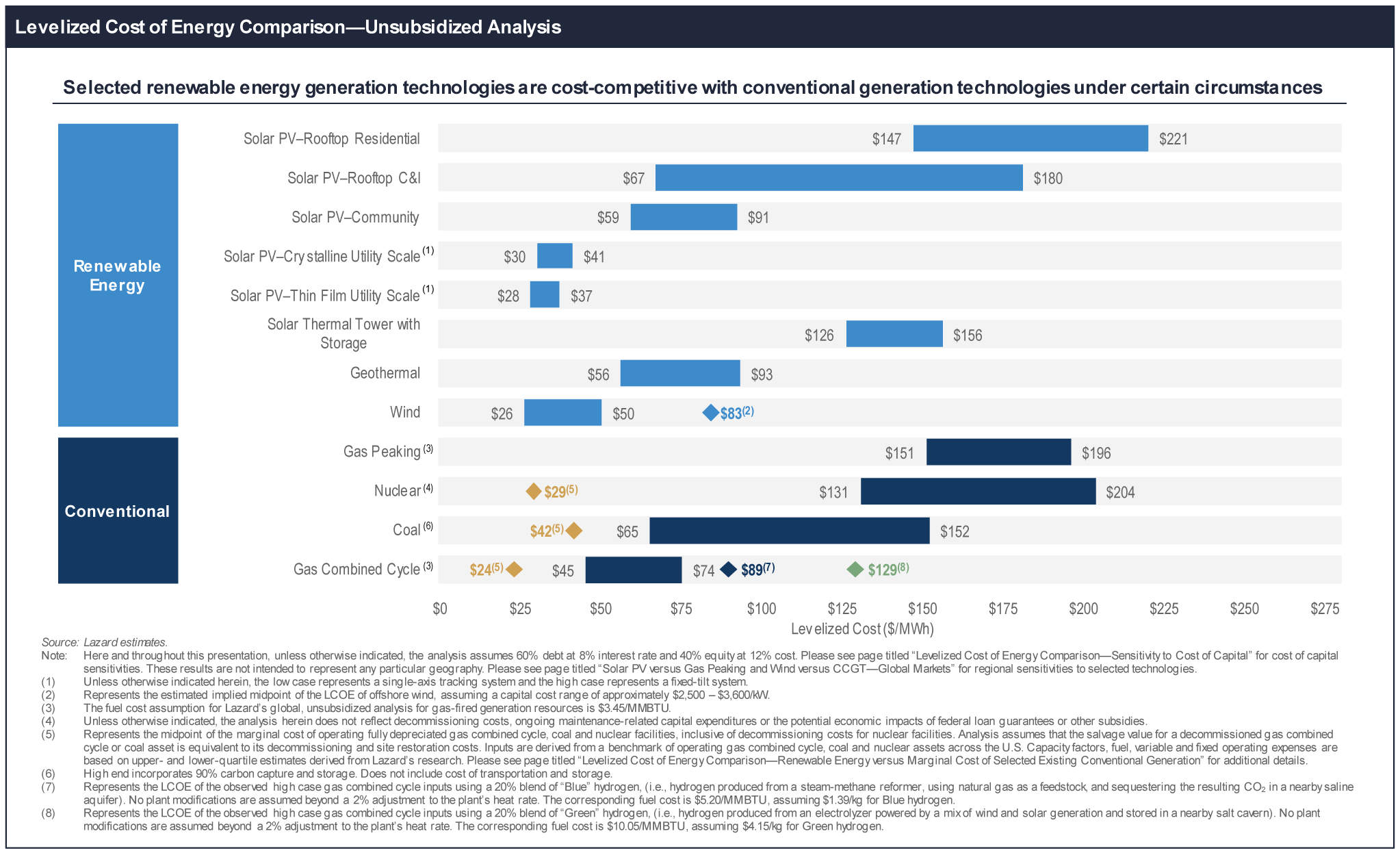 Source: Lazard
Source: Lazard
The second issue is that in the recent past, nuclear power failed to get meaningfully cheaper and instead got more expensive as different power plant projects in the US, Finland and UK experienced delays and cost overruns. As a result, when economists try to incorporate the cost curves (the amount by which a given product gets cheaper when the output is doubled) of different technologies into their electricity grid models, nuclear doesn’t play much of a role at all in the future of our grids (see figure below). This is mainly because the cost trajectories for solar, wind and battery technologies are so steep that even if a mass deployment of them is economically unwise now, it likely will be the cheapest option in 10 years. In the graph, you can see that in all scenarios which were modeled (based on what emission targets we want to hit), nuclear power either remains a constant but small part of the energy mix or vanishes completely. Forecasting the future cost of technologies obviously comes with some uncertainties but the learning rates of industries tend to be surprisingly stable over time. This means that barring any unique, overriding information we should probably bet on learning rates remaining relatively constant over time.
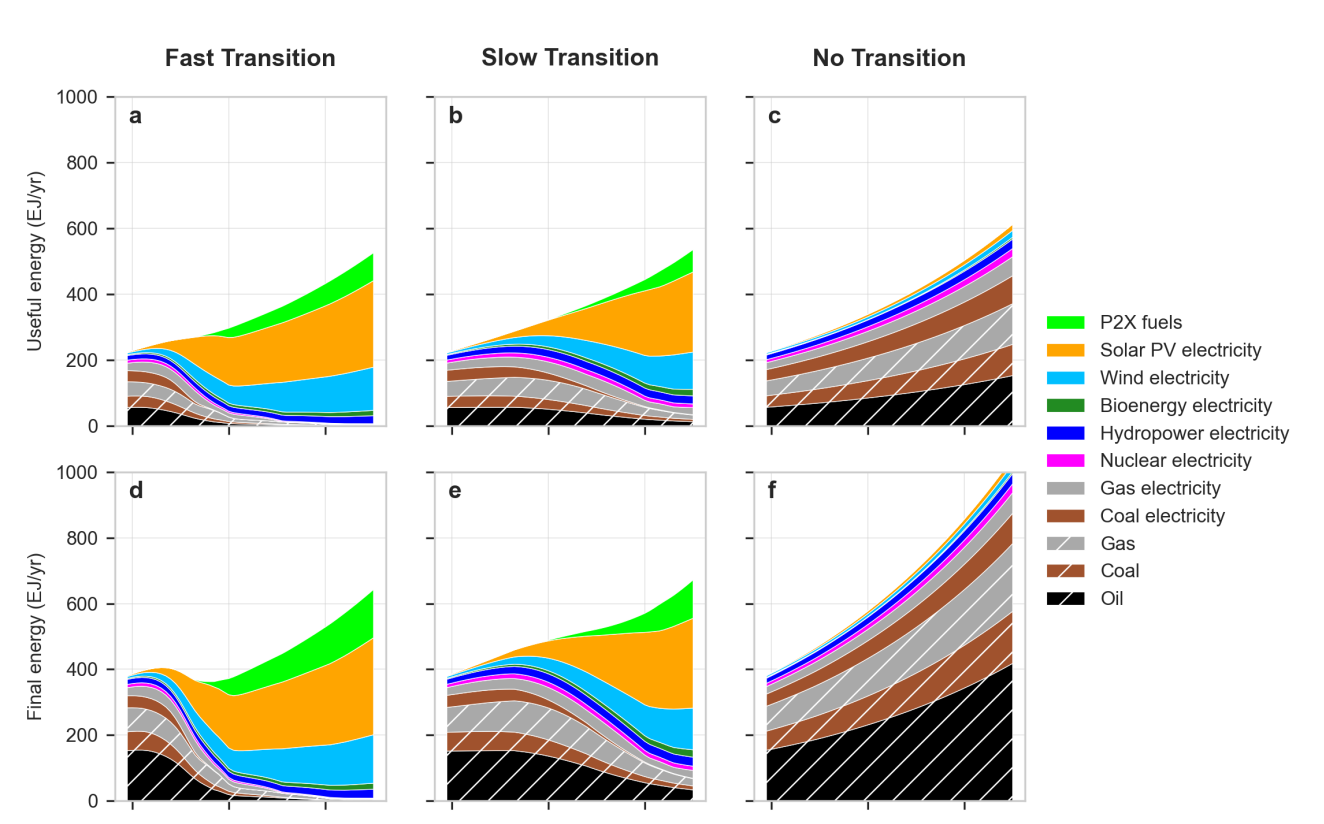
Having established that nuclear power is currently quite expensive and not looking to get much cheaper, the important question is why. Let’s consider possible reasons:
1. No (more) economies of scale
Most of the nuclear power plants in the west were built a long time ago with very few new projects happening in the last 20 years. This means that every single power plant has to be planned and constructed from scratch which creates expenses in long planning and approval processes. Additionally, the small quantity of projects means that it’s also not feasible to mass produce the individual components for plants which further drives up costs.
This is in many ways the opposite trend of technologies like solar panels which have seen rapid cost declines specifically because the sheer scale of production has enabled lots of small savings through standardization processes that compound over time.
2. Overregulation
Some people argue that the main reason for the cost increase of nuclear power is overzealous regulation from agencies with badly aligned incentives. We tried to see if there was any corroborating evidence, but all other sources we looked at (both pro- and anti- nuclear) did not mention over-regulation as an issue. Even the pro-industry documents say that regulation standards are very high and use that as an argument for why nuclear is safe. Apart from some specific calls around changing the regulation of prototype reactors and some regulatory harmonization, we couldn’t find this narrative of broad over-regulation anywhere else.
However, we think that some parts of the current regulatory landscape are suboptimal and there are some concrete measures for improvements. These include
- A reform of the current risk model. The current model assumes that cancer rates scale linearly with radiation which is known to be a bad model.
- Enable more testing. In the status quo, test reactors are treated like production reactors and it is thus infeasible to experiment and innovate.
- Align the incentives of regulators with the industry. The current system punishes regulators for incidents but doesn’t reward them when we produce more energy. Importantly, most regulators are not elected officials (more like examiners) and thus don’t need to keep energy prices low for their constituents.
- Allow arbitration of regulation. Currently, regulators hold a monopoly on power and it is nearly impossible to appeal a decision. One single regulator/examiner can shut down a nuclear power plant on their own and it’s nearly impossible to appeal.
3. It’s just that expensive
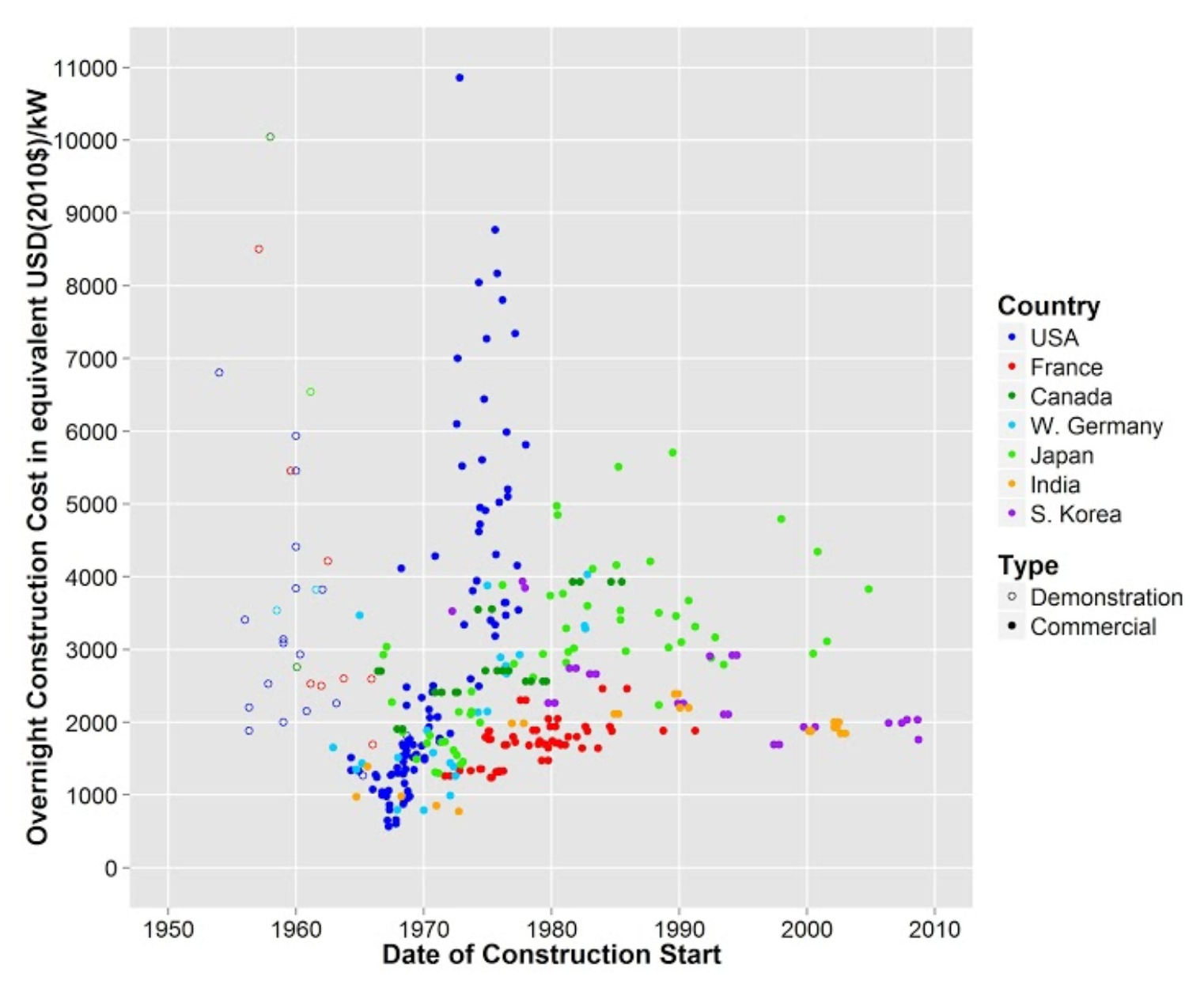

Potentially, nuclear energy is just very complicated and finicky. Combined with rising construction costs in most western countries and big capital requirements it could simply be expensive. However, this doesn’t explain the historical trend of nuclear having been cheap at some point and then getting significantly more expensive over time. It also doesn’t explain why we see a significant geographic variation in construction costs (see figure, though there are also critiques of the validity of this data).
However, construction cost figures from South Korea and China should be taken with a grain of salt. According to a professor Samuel talked to, they have strong PR incentives to make the construction costs appear competitive to secure future projects and existing transparency requirements are insufficient.
Overall, the picture remains complicated. Existing nuclear power plants should definitely be kept running, but building new ones seems too expensive for the time being. It’s unclear if costs can be brought down effectively over time. The malaise of the western nuclear industry seems deep and enduring at this point. Potentially China and South Korea have cracked the problem and with increasing deployments of power plants throughout the global south, they could leverage economies of scale far better than the industry could in the last 30 years. However, this is still early days and without a more solid track record, we can’t confidently say more.
Future nuclear technologies
If you spend enough time on techno-optimist Twitter, you will see lots of hype for molten-salt reactors, small modular reactors, even smaller and even more modular reactors and a plethora of other exciting future nuclear ideas. Most of these ideas are so early in their respective design stages that their commercial viability is completely unclear. Early estimates for their costs don’t even show them being much cheaper (the estimates themselves are uncertain and from 2012). More importantly though, with current implementation timelines, we shouldn’t expect commercial deployment before 2050. Given that we need to already have made significant progress in decarbonizing our electricity grid by then if we want to combat Climate Change, most innovative reactor technologies will simply be too late to matter in this regard.
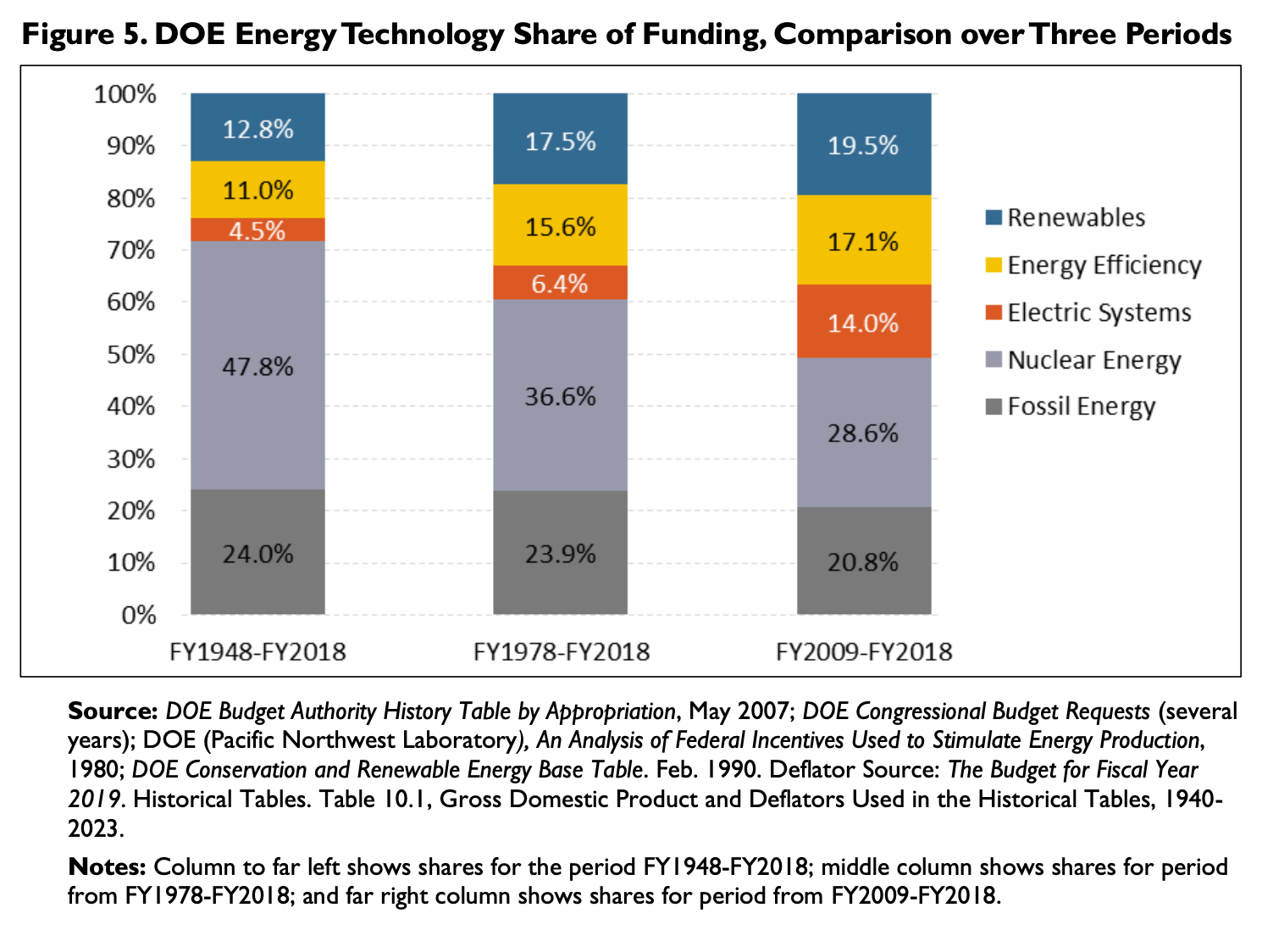
An additional important note about future nuclear technologies is that nuclear energy has consistently received comparatively large amounts of the overall R&D funding dedicated to energy. Even in the most recent time period from 2009 to 2018 when renewables were surging and almost no nuclear power plants were being built, it still got a larger share of DOE funding. Combining the amount of funding with the overall lack of progress should cause us to be more skeptical of claims that better nuclear tech is just around the corner and financially feasible.
The future tech which seems the most ready is “Small modular reactors”, which are scaled-down versions of existing reactor designs (300MW output for an SMR as opposed to 1000-1600MW output for a regular reactor). SMRs could ideally solve some of the problems around the lack of economies of scale by turning reactors into smaller, mass-producible products which could significantly lower unit costs. However, so far this doesn’t seem to be the case and the SMRs that Rolls Royce is building in the UK have relatively high unit costs (expected costs per unit is 1.8bn pounds according to Samuel’s professor). Even then, they are expected to deploy by 2035 if everything goes to plan. Most countries need to make important decisions about their electricity grid investments before then if they want to hit their respective climate goals deadlines. Therefore, even if SMRs work well, they might still be too late to matter.
The role of nuclear in a grid dominated by renewables
If renewables are cheaper than nuclear energy and the trends look like this disparity will only increase, can we just focus fully on renewables? Not necessarily, because renewable energy supply is volatile in a number of different ways. There are predictable daily fluctuations in production (lots of sun at noon, little sun in the evening), predictable seasonal fluctuations (less sun in the winter) and unpredictable semi-regular fluctuations (multi-day events of low wind).
While you can hedge against the predictable fluctuations somewhat through optimizing the ratio of wind to solar resources (the production peaks/troughs of wind and solar cancel out somewhat), seasonal fluctuations and unpredictable events remain thorny problems. This leaves us with two needs for our grids. Flexible short-term generation capacity to offset daily fluctuations and long-term stable production to offset longer time periods of supply-demand mismatch.
Nuclear power is pretty unequipped to handle the first kind of need since most reactors take a long time to ramp production up and down and because the high price tag of nuclear power means that running the reactor at anything less than its maximum production would be economically infeasible. The second need is something that nuclear power could potentially fulfill. Here the question is simply which of the available technologies (battery storage, Pump storage hydro, geo-thermal) ends up being the cheapest and most scalable.
(Disclaimer for this section: modeling electricity grids is very complicated because it combines a bunch of different sources of uncertainty. It’s also highly location-based and subject to lots of crucial assumptions about market behavior, cost curves and weather patterns. Therefore, these considerations can lead to different conclusions for different regions.)
Plausible futures
We think there are broadly two reasonable pathways for the future of energy.
Invest in nuclear, reform and innovate
As we described above, there are many reasons why the status quo of nuclear is far from optimal. The safety regulation is potentially unnecessarily high which increases the price and prevents innovation, current nuclear power plant construction doesn’t use the benefits of economies of scale and there is some research that could improve every step of the cycle, ranging from scale & efficiency over recycling to waste management.
Thus, a future with nuclear would make the necessary changes and hope that the price goes down sufficiently. However, a lot (see section on future technologies) of money has been pumped into nuclear energy research and the results have been less exciting than promised. There is, of course, some chance that previous researchers and lawmakers have had the wrong focus and a better agenda would lead to better results in the future. However, there have been many countries that financed research on nuclear energy and we think, therefore, that there is a non-negligible chance that it’s just harder/less promising than we would like it to be---especially when contrasted with its alternatives.
Invest in renewables and storage
The price of renewables has decreased massively over time. Solar power, for example, is now 99.6% cheaper than in 1976, which implies a ~200-fold reduction, and its cumulative installed capacity has been growing exponentially.
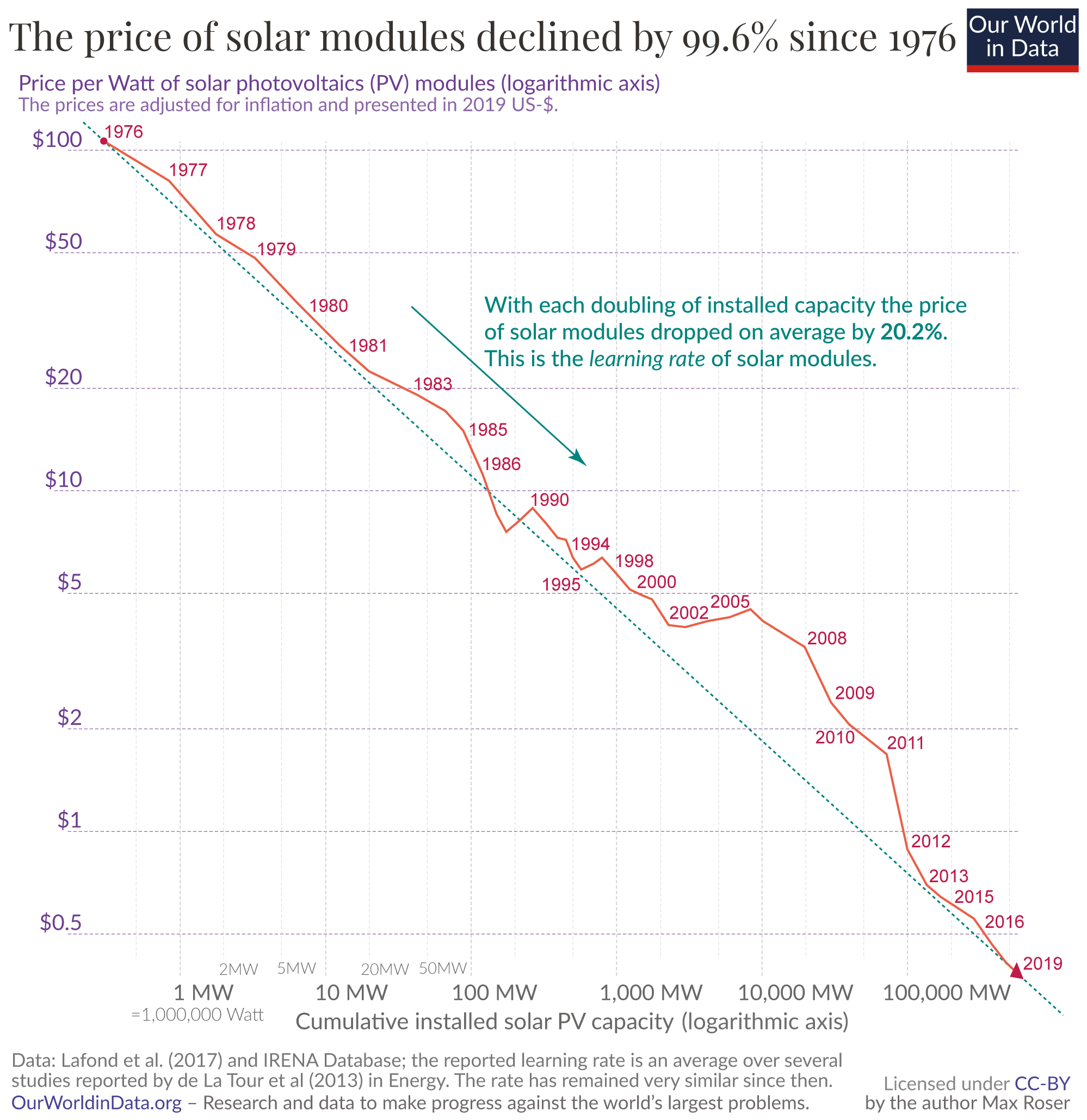
Furthermore, the price of lithium-ion batteries has seen a broadly similar trend since 1995, i.e. exponential drop in price and an exponential increase in cumulative cell capacity.
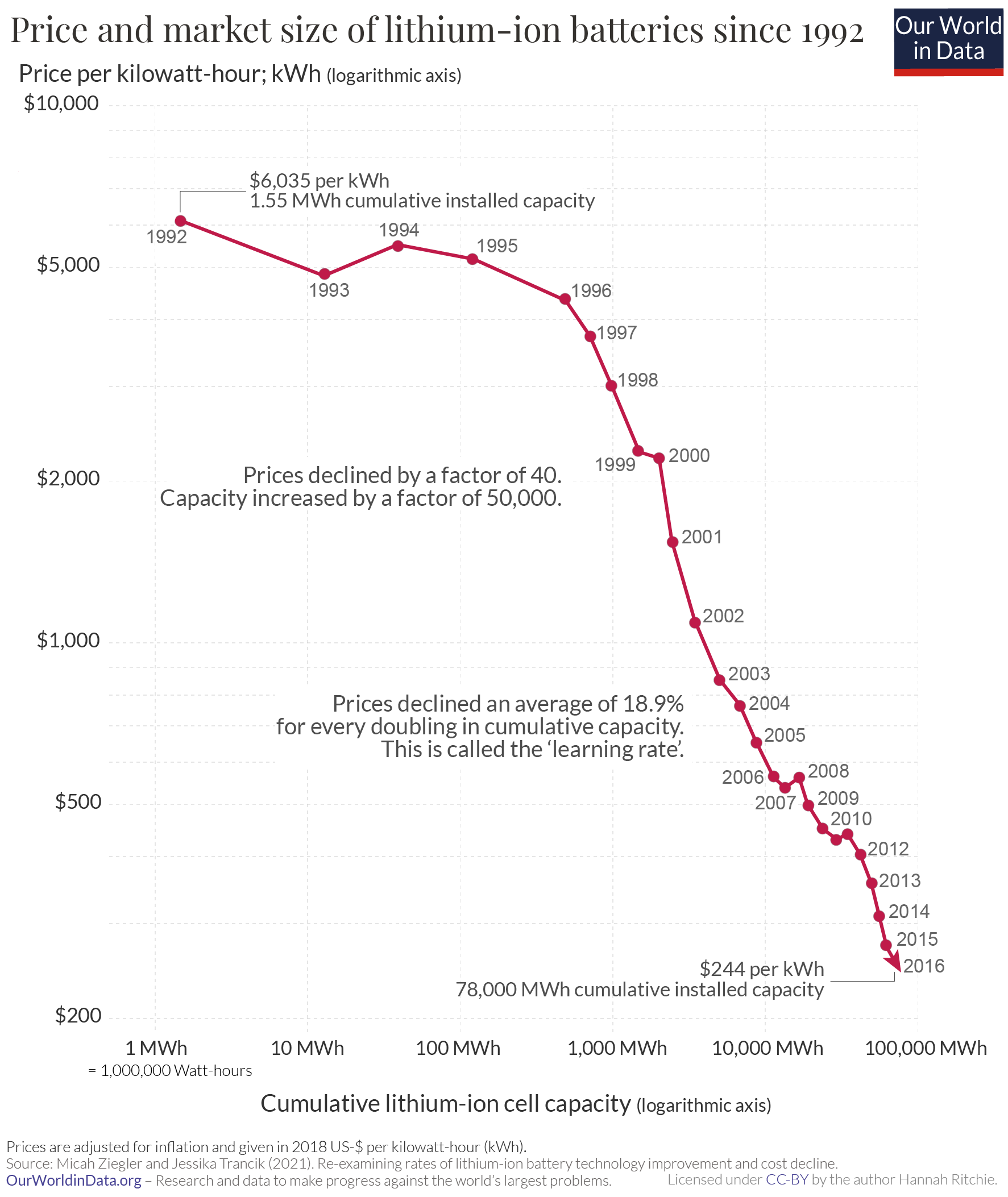
The cost of wind energy has decreased as well but not as steeply as solar. The price of energy from coal has stayed the same and the price of nuclear energy increased by about 1.5x between 2010 and 2019. Furthermore, we are now at a point where generating energy from renewables is cheaper than from fossil fuels or nuclear. The remaining downsides of renewables are a) they depend on external conditions such as wind and sun and b) the energy is generated in a different location from where it is needed and thus needs to be transported.
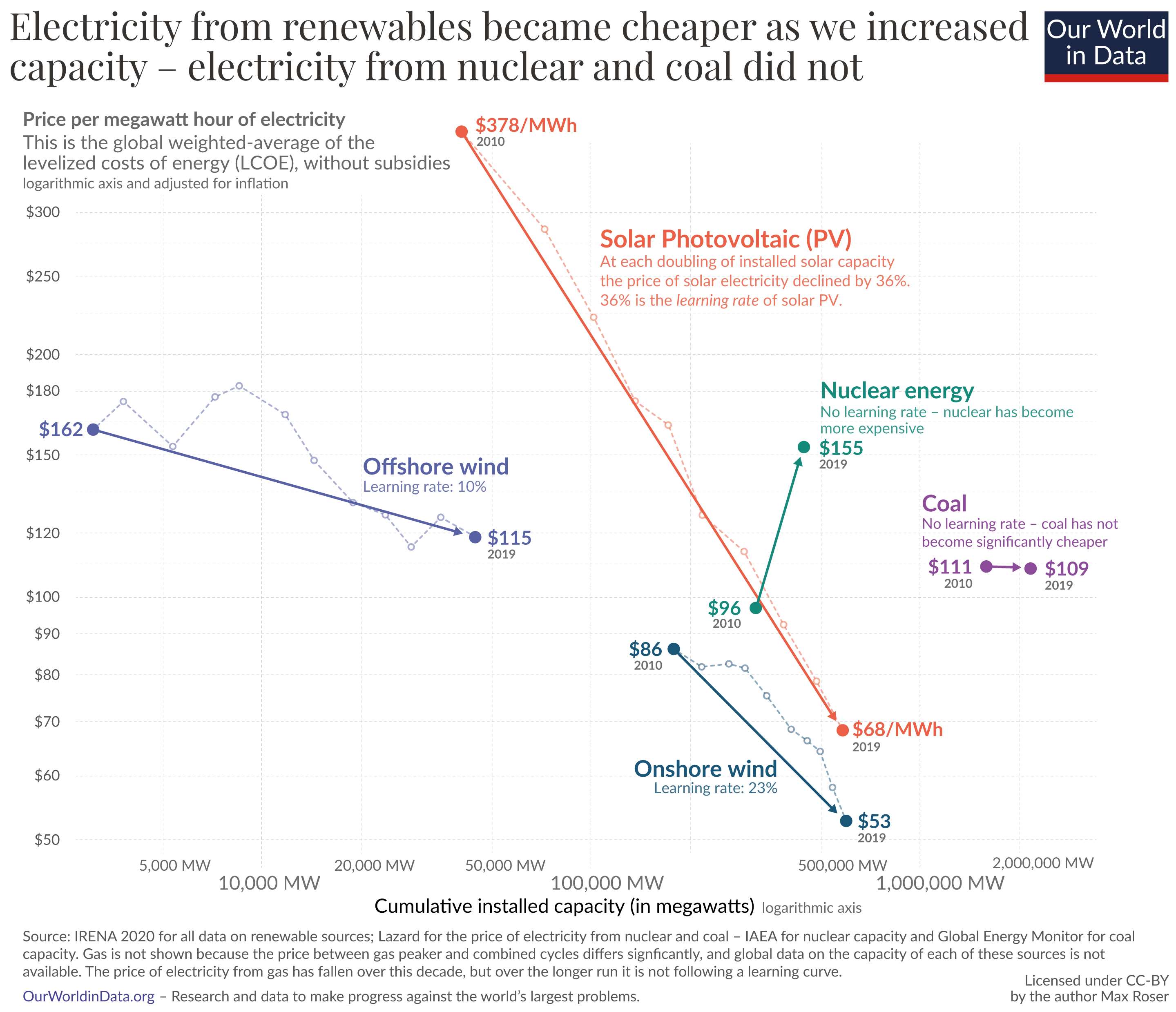
There are plausible ways of solving these problems though. We could build more high voltage lines to solve the transportation issue and there are many ideas to improve storage. These include really large (clusters of) batteries or decentralized solutions where the energy is stored in a large fleet of electric cars. Since stationary battery clusters don’t need to optimize for low weight, different chemicals and setups might be possible (see this start up which claims to produce utility-scale battery tech for 10% of current lithium-ion battery costs). Alternatively, the electric energy could be stored in the form of hydrogen (see e.g. [1], [2]) or ammonia.
None of these storage facilities are sufficiently well developed yet to handle a fully renewable energy system. However, the progress in renewables is moving very fast and research seems to quickly and consistently produce improved capabilities.
Conclusions
We think many of the problems described in public discourse are actually not very big. We don’t think safety is a big problem and we don’t think waste is or will be a big problem. Furthermore, one can make the case that nuclear energy is even overregulated and that safety standards are so high that they effectively prevent new plants from being built (possibly by design). We don’t know what the right level of regulation for nuclear is but it is definitely inconsistent with most other safety standards for food, medicine or fossil fuels when you compare the numbers. However, it is undeniable that the current price of nuclear energy is much higher than for renewables (~2x).
We speculate that this difference in trajectory can be explained by market conditions. It is much easier to mass-produce and standardize solar panels than the construction of nuclear power plants. Thus, we expect this gap in price to grow rather than shrink. Furthermore, energy storage such as batteries has seen very steep increases in price/capacity as well---possibly for similar reasons.
However, in almost all cases, nuclear is much better than fossil fuels. Furthermore, there might be a role for nuclear in the future. It is clean, gives you high energy independence and allows you to build energy production geographically close to where it’s used. Therefore, we think there might be a role for nuclear energy in the future just not a very big one. If we (as the authors) had to decide now, we would double down on renewables and design the role of nuclear around a future grid in which wind and solar dominate the energy supply.
We would like to thank Maria Heitmeier, Laurenz Hemmen, Peter Ruschhaupt, Emil Iftekhar, and Mona Bukenberger for their feedback and comments.
One last note
If you want to get informed about new posts you can follow me on Twitter.
If you have any feedback regarding anything (i.e. layout or opinions) please tell me in a constructive manner via your preferred means of communication.
33 comments
Comments sorted by top scores.
comment by Johannes Ackva (johannes-ackva) · 2022-05-03T11:10:04.925Z · LW(p) · GW(p)
I don't have time to write a super-long comment but as someone who has spent hundreds of hours on this question and turned from an anti-nuclear activist to a pro-nuclear funder, I do want to quickly point out that this post does contain a fair amount of errors / statements outside the relevant context.
1. Nuclear being overfunded compared to renewables: R&D budgets are one thing, but overall support is another. In the early 2000s, the world has spent hundreds of billions of dollars every year driving down the cost of renewables, while the last comparable effort to make nuclear cheap in the West was probably 1970s-1980s France. 2-3B USD in R&D funding are nothing when you have a regulatory process and public that are, by and large, at best lukewarm about nuclear.
2. LCOE and system integration: The discussion on this issue seems not very informed by the challenges of grid integration and system LCOE. You are suggesting that LCOE is biased in favor of nuclear, when the opposite seems more likely to be true given discounting and the fact that the system integration costs of renewables and the challenges around system integration are the primary determinants of slowed down penetration in high-renewable jurisdictions. You also seem to assume that the modular cost declines in something produced in factories are a good proxy for the massive infrastructure required for an all-renewables grid, which seems quite implausible given the lack of progress on transmission, seasonal storage etc.
3. The best argument for nuclear: You do not really seem to engage with what seems the best argument for nuclear, as (i) a hedge against failure of an all-renewables world and (ii) nuclear for hard-to-decarbonize sectors, not only electricity (e.g. hydrogen production, industrial heat).
To be clear, I am not at all certain that advanced nuclear will succeed or that the problems around renewables cannot be overcome, but when you think about marginal attention and additional effort and the structure of climate damage and current effort, marginally adding to what is already the biggest and most popular bet is unlikely to be optimal. If you look at overall attention, getting the conclusion that we over-invest in nuclear seems not justified, certainly not if you look at climate philanthropy and the mainstream climate conversation.
Sorry for lack of specific sourcing here, but relevant materials:
https://founderspledge.com/stories/changing-landscape
↑ comment by Ulrik Horn (ulrik-horn) · 2023-08-31T09:26:40.040Z · LW(p) · GW(p)
I just want to second Johannes' point: A lot of money is going into renewables now and more is expected going forward. This is because we managed to get wind and solar below cost for other power types in many geographies. Once you harness the power of capital, it is pretty large-scale - pension funds are pouring money into renewables and they mostly do not need any more subsidies and having worked in wind energy myself I think I would not mind if all renewables R&D funding instead went to nuclear, for the reasons Johannes outlines. I think nuclear is left to die on the roadside in comparison and it would good to have it ready in case a non-carbon and non-nuclear grid proves really hard, or in case we can make fast-ramping nuclear that is cheaper than other ways to fill in when renewables are not producing. We want all the tools in out toolkit heading into the wild and uncertain road ahead that is the energy transition.
↑ comment by Marius Hobbhahn (marius-hobbhahn) · 2022-05-04T07:39:43.835Z · LW(p) · GW(p)
Thank you for your expertise and criticism.
Just to be clear, we still think nuclear is good and we explicitly phrase it as a high-risk, high-reward bet against the failure of renewables. Furthermore, we very explicitly say that nuclear is better than all fossil alternatives which also implies that we would be in favor of having more nuclear.
I think our overall framing is more like: get away from fossil fuels, a bit more into nuclear and much more into renewables. If you think that is not clear from the text, we should definitely clarify this. Let me know how you understood it.
comment by cwillu (carey-underwood) · 2022-04-30T18:47:17.126Z · LW(p) · GW(p)
The appendix of https://thedonjonesarticles.wordpress.com/2018/07/22/why-ontarios-candu-nuclear-reactors-dont-load-follow/ suggests that the inability to load-follow is regulatory in nature:
“So what is the present situation with our neighbour, the United States. Just like in Canada. In the U.S. the NRC (Nuclear Regulatory Commission) prohibits load-following, primary frequency response, and AGC even though the units are likely capable of it (reference 3). They can perform a planned load-cycle (called load-shaping) by changing reactor power under the control of a licensed operatorfollowing procedures approved by the NRC for that unit but load-following, primary frequency response and AGC are prohibited.
In France (because of large share of nuclear electricity on its grid) and in Germany (because of large amount of variable wind and solar generation on its grid) some nuclear units, basically similar to units in the U.S., do load-following, that is, make changes in power as the grid demand changes during the day and week. Units also provide primary frequency response, and AGC. Not all units are needed for load-following and a significant number operate baseload.”
comment by Victor Cody Toth (victor-cody-toth) · 2022-05-02T01:49:56.937Z · LW(p) · GW(p)
Please excuse my lack of sources, I am writing this on a phone in the middle of the night, it's just that big an issue. You should be able to verify my statements if any are in doubt, though I try my best to explain.
One simple and very clear error that you have made is about the role of nuclear in a renewable world. From an engineering perspective it is simply literally not solvable to run the grid without it. This is the lynchpin of your entire essay. All the other things do not matter if you can not replace nuclear by anything other than fossil fuels.
a) Without meaning to offend, saying that you will run the grid off of batteries is such an absolutely insane proposition that it boggles the mind, and usually comes from people in the humanities. You only worried about costs here, but the physical feasibility is literally nonexistent from an engineering and logistics point of view. Battery storage technology might work for small unincorporated communes in australia, but not for even a single industrial consumer much less a national energy grid. The difference is several orders of magnitude. A few MW demand being smoothed over for a few hours, which musks australian battery farm is capable of, is less than the demand of a single steel mill. The same battery farm by the way also failed to function in four months in 2019 for which the operator is now being sued. Normally out there ideas that musk has can be supported, but even he doesn't think this tech could carry the grid. Thinking that it could is lunacy. Apart from the lack of scale, there are other engineering issues like the incredible fire hazard, the non solved logistics of large scale (or even consumer scale) battery recycling, storage losses, capacity degradation (the australian project has only 15 years warranty), as well as the simple lack of production capacity, since we are already hitting supply chain bottlenecks for EV batteries.
b) For all the fuss about how great battery stored solar is, you unfortunately forgot to consider THEIR initial setup. Making non perovskyite solar cells and lithium batteries are two of the most toxic industrial processes with lots of waste. The only reason the extreme price decreases were possible was that china being the main producer has basically no enforced environmental regulations, with literal open lakes of toxic sludge seeping into the ground in inner mongolia.
c) Battery stored solar is NOT renewable. The earth has limited easily extractable resources of lithium and silicon. There is already a shortage of rare earth metals associated with Li Ion battery production. Last time it was Mn i think, because some processor in china could not keep up with demand but i can't find the news article. Research into alternatives is ramping up, but no good results are available yet. Global reserves could last a couple hundred years, but extraction efforts already can not keep up with current demand. If this demand increases by magnitudes by trying to store electricity in batteries even the global reserves could be used up sooner rather than later. As in we could possibly be facing peak-battery, before peak-oil.
d) Pumped hydro is complete nonsense, as even when you disregard the massive environmental destruction it causes and the potential for catastrophe, you are still left with the fact that you can only build pumped storage in very, very, VERY specific locations. You not only need a mountainous area that is high enough with steep enough slopes and a narrow enough valley, you also need a very specific ground structure beneath the topsoil for the dam structure, essentially bedrock up high in the mountains, and rocks without horizontal faults for the basin. Building even small dams on just slightly off rock has already resulted in catastrophe in the past, and worrying developments like the three gorges dam shifting. The utilization of hydroelectric potential is almost complete which you can see by there being zero new ones planned that I know of, despite the push for renewables.
e) Not only is wind about the most unpredictable thing in physics short of QM particles, solar is ALSO not predictable. For the same reason: weather. And we can not circumvent this by putting them all in the sahara, because transport losses with our current tech are enormous the sand destroys tracker servos and panel surfaces, and that's disregarding issues with security and political security. All european imported solar projects that have been proposed in the past are currently on hold, despite the push for more renewables. Someone put up xlink as an example, but that too is not yet out of the planning phase.
f) In most of the world rooftop solar is not NEARLY enough to cover the needs of the household in the winter. In most of europe you need heating running 24/7 in the winter months. Why? Because the incoming solar radiation is not enough to heat up the house. You can mitigate this by installing heatpumps in literally every single household, but it's likely that you still will not get enough energy for that, because even with fossil fueled heating, rooftop solar isn't enough to provide electricity for a family home in the winter north of the alps.
g) You could try and mitigate weather fluctuations by having a very interconnected grid on a large scale, but this is associated again with massive losses in transport, and it is also not a complete protection. What happens when there are several bad weather fronts near all solar power plants? The entire continent being under cloud cover is rare but not unheard of. So what? The energy grid goes down we freeze like the texans did last year? Except here this is would be an accepted risk, not a freak accident. Doesn't seem like an acceptable risk to me.
h) Wind as something to balance solar is a pretty good thing.... if you can build it. But windfarms require a place where windspeeds are 20+km/h to produce and where the wind is always below hurricane speeds to survive. There are entire countries where you have no suitable area for them. Nuclear plants meanwhile can be built almost anywhere.
i) Hydrogen COULD be a nice solution for energy storage, except for one thing: It is nigh impossible to store, not to mention safely. Look at how fuel cells for cars are still a tiny market and EVs have taken over precisely because of this. Granted having storage be immobile mitigates some of the risk, but getting hydrogen to not leak is a nontrivial industrial engineering challenge. Additionally massive infrastructure expansions would be needed to transition to a hydrogen based energy economy. There simply is no prototype, no precedent for grid scale hydrogen energy storage. We have small energy storage solutions with hydrogen for homes, but that's the same scale that we also have carbon recapture already available as well, and i don't see you making the point of just keeping to fossil fuels and wood burning and recapturing the carbon later. Ramping up the scale here would be similarly difficult would it not?
j) As others have already pointed out nuclear powerplants are very much capable of and engaged in regulating their output to conform to grid demands, which means that they are solving a problem that renewables create.
The above is THE biggest cluster of issues with your opinion. Until we have fusion there is simply no way around nuclear if we want to avoid fossil fuels.
A smaller but still important problem in your assessment is the only other negative side of nuclear that you mentioned: Economics.
One issue with this is that you seriously overestimate the benefits of renewables. Renewables are cheap because they are currently subsidized by many governments. Their installation as well as the price per kWh. Furthermore they are NOT easier to install than nuclear. Building a 1GW nuclear plant takes 5+ years, building a gas plant takes 2+ years, while building a simple 50MW windfarm takes 6+ months. Obviously the installation times do not scale linearly, but with 1 month for 10MW, it's a close enough estimate. So if you wanted to install separate windfarms to account for just one nuclear plant it would take you 10 years instead of 5. So i think you can't blame nuclear being cheaper on disregarded interest. And that's not covering the loss of value through making vast areas of land unfarmable with wind and solar, and the ecological damage of covering fields in darkness or in bird chopping soil compactors. Finally the biggest issue with the economic modeling is that it is not borne out by reality. Renewables are expensive. Very much so. In germany 1kWh is ~33ct in a regular tarrif, and ~31ct in a tarrif exclusively using renewable sources. The issue? This includes a ~4ct punitive tax on non renewable electricity production / kWh. Plus it doesn't factor in the state helping finance renewable projects. It's not just fossil fuels pulling the price down either, because in france where nuclear is widespread, the price is just 18ct/kWh. I do not know how the LCOE estimates deal with state or local subvention or punitive taxes, but this might be one thing distorting those estimates compared to real world figures. LCOE estimates and graphs can be made as much as you want but at the end of the day it's the actual prices that matter, and in countries with nuclear the prices tend to be lower than in ones without.
All in all, the only arguments against nuclear that you had are simply not supported by physics and reality. It will not be possible to replace nuclear in the mid term (a few decades) without a technological miracle or going back to fossil fuels.
Replies from: ulrik-horn, npostavs↑ comment by Ulrik Horn (ulrik-horn) · 2023-08-31T09:20:05.026Z · LW(p) · GW(p)
I think that to make your above arguments, you would have to engage with literature on whole-system electric grid modeling. That has been done many times and I trust experts when they say that we can create cost-efficient, complete and reliable electricity systems in many geographies using mostly renewables (some say all renewables). Then nuclear, or bio+co2 capture (negative emissions), or hydrogen could fill in for the last bit.
In short, you would have to go into details behind these models and show why they are wrong in order to say a mostly renewable grid is infeasible. If you are right, it is urgent! Because we are headed in the direction of a ton of renewables and then as we get close to saturation we need to put in place measures to take care of what renewables cannot supply. If that cannot be done we need to quickly make drastic changes!
Here is one example modelling Sweden's future electricity system with and without nuclear showing that nuclear or no nuclear seems to be about the same cost in a cost optimized system, based on total system cost.
↑ comment by npostavs · 2022-05-04T12:24:20.148Z · LW(p) · GW(p)
So if you wanted to install separate windfarms to account for just one nuclear plant it would take you 10 years instead of 5.
This is a minor point, but aren't you ignoring the additional parallelization possible with building 20 windfarms vs 1 nuclear plant?
Replies from: victor-cody-toth↑ comment by Victor Cody Toth (victor-cody-toth) · 2022-05-06T02:18:11.082Z · LW(p) · GW(p)
I am, that's why i mentioned that construction times obviously won't scale exactly linearly with capacity... but i also stated that the same source gave a 1 month timeframe for a 10MW plant, so from the data i could find it is pretty linear. 1 month for 10MW vs 6 months for 50MW I don't know why it can not be parallelized more, but i would also guess that is has to do with the production of parts and warehousing them being nontrivial due to sheer size.
comment by Marius Hobbhahn (marius-hobbhahn) · 2023-12-16T21:18:35.156Z · LW(p) · GW(p)
I think I still mostly stand behind the claims in the post, i.e. nuclear is undervalued in most parts of society but it's not as much of a silver bullet as many people in the rationalist / new liberal bubble would make it seem. It's quite expensive and even with a lot of research and de-regulation, you may not get it cheaper than alternative forms of energy, e.g. renewables.
One thing that bothered me after the post is that Johannes Ackva (who's arguably a world-leading expert in this field) and Samuel + me just didn't seem to be able to communicate where we disagree. He expressed that he thought some of our arguments were wrong but we never got to the crux of the disagreement.
After listening to his appearance on 80k: https://80000hours.org/podcast/episodes/johannes-ackva-unfashionable-climate-interventions/ I feel like I understand the core of the disagreement much better (though I never confirmed with Johannes). He mostly looks at energy through a lens of scale, neglectedness, and traceability, i.e. he's looking to investigate and push interventions that are most efficient on the margin. On the margin, nuclear seems underinvested and lots of reasonable options are underexplored (e.g. large-scale production of smaller reactors), both Samuel and I would agree with that. However, the claim we were trying to make in the post was that nuclear is already more expensive than renewables and this gap will likely just increase in the future. Thus, it makes sense to, in total, invest more in renewables than nuclear. Also, there were lots of smaller things where I felt like I understood his position much better after listening to the podcast.
comment by TLW · 2022-04-30T17:57:39.316Z · LW(p) · GW(p)
First, nuclear power is expensive compared to the cheapest forms of renewable energy and is even outcompeted by other “conventional” generation sources [...] The consequence of the current price tag of nuclear power is that in competitive electricity markets it often just can’t compete with cheaper forms of generation.
[snip chart]
Source: Lazard
This estimate does not seem to include capacity factors or cost of required energy storage, assuming I read it correctly. Do you have an estimate that does?
Replies from: PeterMcCluskey, marius-hobbhahn↑ comment by PeterMcCluskey · 2022-05-06T01:40:32.887Z · LW(p) · GW(p)
Paul Christiano made some estimates here.
↑ comment by Marius Hobbhahn (marius-hobbhahn) · 2022-04-30T18:38:46.310Z · LW(p) · GW(p)
Unfortunately, we didn't find a good source for that. However, given that fossils usually don't need storage and solar+batteries are dropping exponentially in price, we think both options should be cheaper. But good estimates of that would be very welcome.
Replies from: TLW, danny-grossman↑ comment by TLW · 2022-04-30T23:53:20.895Z · LW(p) · GW(p)
solar+batteries are dropping exponentially in price
Pulling the data from this chart from your source:
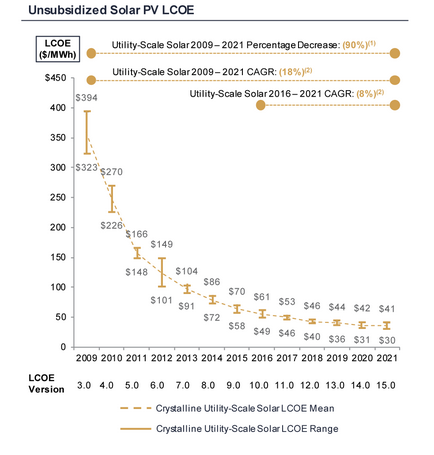
...and fitting[1] an exponential trend with offset[2], I get:
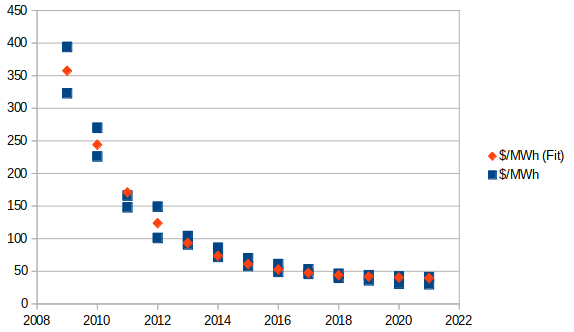
(Pardon the very rough chart.)
This appears to be a fairly good fit[3], and results in the following trend/formula:
This is an exponentially-decreasing trend... but towards a decidedly positive horizontal asymptote.
This essentially indicates that we will get minimal future scaling, if any. $37.71/MWh is already within the given range.
For reference, here's what the best fit looks like if you try to force a zero asymptote:
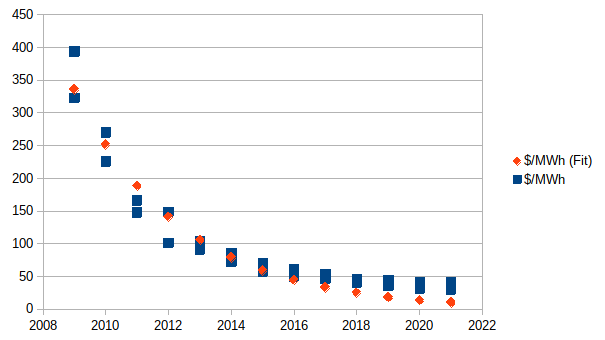
This is fairly obviously a significantly worse fit[5].
Why do you believe that solar has an asymptote towards zero cost?[6]
fossils usually don't need storage
Absolutely, which is one of the reasons why in the absence of wanting clean energy people tend to lean towards fossil fuels.
- ^
Nonlinear least squares.
- ^
I'm treating the high and low as two different data points for each year, which isn't quite right, but meh.
- ^
Admittedly, just from eyeballing it.
- ^
Yes, this could be simplified. That being said, I get numerical stability issues if I don't include the year offset; it's easier to just include said offset.
- ^
Admittedly, this is a 2-parameter fit not a 3-parameter fit; I don't know offhand of a good alternative third parameter to add to the fit to make it more of an apples-to-apples comparison.
- ^
As an aside, people fitting exponential trends without including an offset term and then naively extrapolating, when exponential trends with offset terms fit significantly better and don't result in absurd conclusions, is a bit of a pet peeve of mine.
↑ comment by Danny Grossman (danny-grossman) · 2022-05-01T18:52:00.391Z · LW(p) · GW(p)
See below- I made some estimations based on literature and analyzed a current large scale project.
cheers,
Danny
comment by TLW · 2022-04-30T17:51:16.719Z · LW(p) · GW(p)
Thirdly, nuclear power gives you energy independence. This became very clear during Russia’s invasion of Ukraine. France, for example, had much fewer problems cutting ties with Russia than e.g. Germany. While countries might still have to import Uranium, the global supplies are distributed more evenly than with fossil fuels, thereby decreasing geopolitical relevance. Uranium can be found nearly everywhere.
Also, you can extract uranium from seawater. This has its own problems, and is still more expensive than mines currently. However, this puts a cap on the cost of uranium for any (non-landlocked) country, which is a very good thing for contingency purposes.
(Also, there are silly amounts of uranium in seawater. 35 million tons of land-based reserves, and 4.6 billion in seawater. At very low concentrations, but still.)
comment by ChristianKl · 2022-05-05T15:46:18.204Z · LW(p) · GW(p)
An additional important note about future nuclear technologies is that nuclear energy has consistently received comparatively large amounts of the overall R&D funding dedicated to energy.
It seems misleading to me to cite research costs that include research for nuclear fusion but only discuss the use of nuclear fission.
However, it is undeniable that the current price of nuclear energy is much higher than for renewables (~2x).
It's easy to deny it. It depends on how you measure the price. If you measure the average energy output of a solar cell, the average energy is cheaper. If you however measure the lowest energy output of the solar cell per year because you want to have energy 24/7/365 nuclear is cheaper.
People can drown in a river that's 0.5 meters deep on average.
These include really large (clusters of) batteries or decentralized solutions where the energy is stored in a large fleet of electric cars.
You can use batteries like that for storing energy for a few hours or days and then release it. That approach doesn't help you to use energy from the summer for the winter.
comment by Carlos Javier Gil Bellosta (carlos-javier-gil-bellosta) · 2022-05-02T20:42:52.244Z · LW(p) · GW(p)
The article mentions Lazard's levelized cost of energy report. I reverse engineered the spreadsheets on which the report results are based and put them online here in case somebody wants to recreate the scenarios, stress them differently or create new ones.
Replies from: Mo Nastri↑ comment by Mo Putera (Mo Nastri) · 2023-12-17T09:37:31.624Z · LW(p) · GW(p)
I just tried your link but got a "This site can’t be reached" error.
comment by Vaniver · 2022-05-02T18:04:20.691Z · LW(p) · GW(p)
It seems to me like this is a little inconsistent in how it treats the storage needs of nuclear and wind/solar. If you have a good energy storage solution, then 12-hour adjustment times are fine, and variable supply is also fine. The question is something like: how much storage do you need, as a fraction of load, and how efficient can that storage be, and how much does it cost?
[For example, my favorite storage solution when I looked into this years ago was phase change materials; dump the thermal output of the reactor into a large reservoir of salt at its melting point, which moves more of it from solid to liquid; run steam thru other pipes to drain energy from the reservoir, turning some of the salt from liquid to solid, and then push turbines using the steam to generate electricity. The moment-to-moment electric output of the plant is now determined entirely by how quickly you pump steam, which is easy to adjust, you have plenty of warning if you need to stop the reaction and so stop dumping heat in, and the reservoir is held at a consistent temperature, which reduces wear on components. Apparently this is what TerraPower is using for its prototype plant, and so it's still one of the better ideas out there.]
I could buy that actually solar needs less batteries (or the equivalent) than nuclear does, but it feels to me like that's the modeling that needs to happen here, and my queuing theory intuition is that that probably isn't the case. Nuclear's storage situation for the typical case is bad, since it needs to store ~8hr of night-time production for the day-time peak, whereas I think the typical case for solar is more like ~2hr of storage because the consumption peak and production peak are only off by ~2hr, but if you're shooting for something like three nines of uptime, the "worst thousandth" situation for solar seems like it requires way more storage than the "worst thousandth" situation for nuclear. There's still maybe gains here if there's storage mechanisms that are cheap only if you use them infrequently and slowly, but I'd currently bet against solar having better storage prospects. [That said, the overall cost for solar could still be lower, even if it pays slightly more for storage, if it pays less for generation.]
comment by Dave Orr (dave-orr) · 2022-04-30T17:35:08.944Z · LW(p) · GW(p)
Thanks for a super clear and well written overview!
comment by chemslug · 2022-04-30T16:48:39.644Z · LW(p) · GW(p)
Thanks for this! Austin Vernon took a look at why the nuclear industry isn't growing and came to some broadly similar conclusions here. I think a lot of environmental groups have gotten themselves into a situation where "nuclear power is evil" is kind of taken as a given, while the techno-optimist crowd is overly sanguine about cost problems being driven by regulations and the chances of those regulations changing. in other words, there's a lot of people with different assumptions and values talking past one another in this debate. Continuing to pump money into next-gen nuclear research seems like a reasonable use of money to me because the potential payoff is big enough to outweigh the low-ish probability of success. You could say the same about lots of branches of renewables research (e.g. perovskite solar cells) though.
Replies from: conor-sullivan↑ comment by Lone Pine (conor-sullivan) · 2022-05-01T13:48:44.164Z · LW(p) · GW(p)
In my opinion the most baffling (and angering) part of this post was the chart of DOE energy technology research investment from 2009-2018. Forget about the nuclear spending, how is it that, during the Obama administration, we spent more researching fossil fuel tech, which is supposed to be a dead technology, than we spent on what almost everyone agrees will be the future of energy, renewables? I wonder what percentage of that is carbon capture and storage, what percentage is discovery and extraction, and what else we're throwing our money away on. The big oil and gas companies are some of the most profitable companies in the history of the world, can't they pay for it themselves? Why are taxpayers paying to make the environment worse? It's madness!
comment by Veedrac · 2022-05-03T01:19:10.174Z · LW(p) · GW(p)
Absolute government spending numbers on fission research isnt very informative when the government is capable of being arbitrarily inefficient at research. Space flight (SLS/Orion) and fusion (ITER) demonstrate this clearly, with the bulk of government investment largely being unhelpful, despite being large.
I haven't looked into what this spending is on for fission, but I have heard that it is basically impossible to test new designs ever, so I would not expect anybody in the US to be able to demonstrate good progress efficiently even if they were more competently run than those other examples.
comment by Vaniver · 2022-05-02T18:13:16.919Z · LW(p) · GW(p)
Most of the nuclear power plants in the west were built a long time ago with very few new projects happening in the last 20 years. This means that every single power plant has to be planned and constructed from scratch which creates expenses in long planning and approval processes. Additionally, the small quantity of projects means that it’s also not feasible to mass produce the individual components for plants which further drives up costs.
This is in many ways the opposite trend of technologies like solar panels which have seen rapid cost declines specifically because the sheer scale of production has enabled lots of small savings through standardization processes that compound over time.
But this is surely a choice, right? Framatome's designs are pretty standardized, because they decided to build a lot of them at once. If we decided to build twenty new plants instead of two, what is stopping us from using the same design for each of the twenty?
comment by Danny Grossman (danny-grossman) · 2022-05-01T17:55:08.832Z · LW(p) · GW(p)
Thanks! I love your paper- very concise and well written.
I am also an amuature and very new to thinking about future energy market and technology, but here goes:
When looking at pricing (even LCoE), you should compare intermittent energy sources (PV, wind) to baseload sources (nuclear or fossil) when taking into account additional energy storage costs.
The "solar load", or duty cycle (total energy produced/time vs. peak power possible by adding up solar panel rating) is low: 10-20% in sunny areas of the globe, peaking at 30% in the Sahara. The LCoE takes the load factor into consideration I believe. But in the time Solar (or wind) is not producing, we need energy storage to step in (if we want to avoid fossil or nuclear). Battery storage LCoE is 3-4 orders of magnitude more expensive currently than energy production, at ~600-300 $/KWh compared to 0.065$/kWh for PV (note units of KiloWatt vs MegaWatt in your chart) .
A paper from 2019 ( here ) shows that if storage needs to make up for 100% of power availability by compensating a combined solar wind solution , it should drop by 1 order of magnitude to 20$/kWh. to be viable now, we need to compromise on availability.
I am unsure that battery cost will continue to drop exponentially: according to this department of energy study from 2021 , they are expected to level out at 100-300 USD/kWh:
figure from DOE paper
Note the cost to build is much cheaper for batteries (400$/kW compared to 1300W/kW for solar). I guess that storage is so bad in terms of LCoE due to its limited number of cycles (life time) and charging losses (10-15%)
Lets try to get a feel by looking at a recent real example of a project : the Xlinks Morrocan - UK project. This project (recently launched) has 10.5GW of solar and wind in Morocco, with 20GWh battery storage, and running 3800km of high voltage lines to UK (yes, 3800km power lines). The output on the UK side is 3.6GW, "20 hours a day". Cost is 22B$. They go all the way to the Sahara to enjoy 34% solar load and 51% wind load (very high indeed). Note that it probably makes economic sense to go 3800km south to increase load factors significantly (because storage is so expensive, even adding a cable it is still worth it). I did some very crude approximation here: Using reported numbers, published optimistic estimations and 0% interest rate (!), I got LCoE of about 105$/MWh for the system as a whole. Compare that to 65 and 53 $/MWh reported without storage, and we see that storage can double the cost, even if it just a small percent of the total power (20GWh compared to ~100GWh solar+wind) , and even though this system is specified to provide power only 20 hours a day.
.
Replies from: victor-cody-toth↑ comment by Victor Cody Toth (victor-cody-toth) · 2022-05-02T02:36:03.254Z · LW(p) · GW(p)
One issue here is that from what I can cather the Xlinks project is still in the planning phase. There have been similarly ambitious projects in the EU in the past, and all were eventually shut down. In other words even the estimates there might be too optimistic. For example multi-MW scale energy storage in batteries over several hours would be as much of a first as an energy breakeven in fusion from my knowledge.
Replies from: danny-grossman↑ comment by Danny Grossman (danny-grossman) · 2022-05-02T05:43:43.603Z · LW(p) · GW(p)
Thanks Victor. I agree, even for the optimistic planning phase it seems that the project is cost comparable to nuclear (with 3.6GW nuclear set up costs being 22B$) but provides "average 20h a day power". timeline is stated to be 2029, again, in the ballpark of nuclear energy of 5-10y.
So this project is not quick nor cheap and you get much less than nuclear power (with current day reactor technology, working in the field for several decades).
BTW: it is planned to take up 1500 square kilometers, another reason to be in the desert...
Probably not a rational cost effective choice.
comment by TheMajor · 2022-05-01T13:01:07.240Z · LW(p) · GW(p)
My previous go-to for understanding why we didn't adopt nuclear power on a massive scale is https://rootsofprogress.org/devanney-on-the-nuclear-flop (even citing some of the same sources and using the same charts). Note that the post summarizes Devanney's book, and the post author does not necessarily agree with the conclusion of the book.
Devanney places a lot of the blame with regulators, in particular the Linear No Threshold model, ALARA legislation and regulator incentives. Do you think this is inaccurate and/or overblown?
Replies from: marius-hobbhahn↑ comment by Marius Hobbhahn (marius-hobbhahn) · 2022-05-01T16:46:27.466Z · LW(p) · GW(p)
We discuss this in our post. We think it is a plausible story but it's not clear if decisive. Most people who are critical of the status quo don't see regulation as the primary issue but I'm personally sympathetic to it.
comment by Ulrik Horn (ulrik-horn) · 2023-09-02T10:15:41.966Z · LW(p) · GW(p)
Another argument against nuclear is that it could make nuclear disarmament more challenging. From my quick reading on the topic, the recent construction of UK's Hinkley Point C might have been in part to support a UK nuclear eco-system that is shared with its Trident nuclear submarine fleet. The authors Stirling and Johnstone seem to be well regarded based on a quick look at their research profiles.
comment by Ulrik Horn (ulrik-horn) · 2023-08-31T13:22:05.738Z · LW(p) · GW(p)
On the topic of regulation/safety - it seems wind, solar and nuclear are all super safe when looking at deaths per TWh:
I have heard many times rationalists/effective altruists saying that nuclear is over regulated and when both the authors failed to find evidence for this claim, and OWID does not show this (I think one could instead make the case that fossil fuels are under regulated) I think it is time to bury this seemingly misguided meme.
comment by Miles Hawthorne (miles-hawthorne) · 2022-05-01T18:11:18.252Z · LW(p) · GW(p)
From my years of reading about nuclear energy I have seen that a large majority of the research on forms of energy, especially in direct comparison, utilize a time period of thirty years before the capacity is no longer productive or maintainable. This is within the lifespan of solar and wind. It is half of the operating lifetime of a nuclear reactor, sixty years -- although there's been some enthusiasm by owners to extend pemits to eighty years which I believe would be unsafe when exceeding the design lifetime. If something with a lifecycle of thirty years is compared to something with a design lifetime of sixty years with an imposed thirty year lifecycle for comparison purposes but with a similar yearly cost, the result will be it's twice as expensive on a thirty year basis.
Separately, if the federal government would underwrite bonds for construction of nuclear power stations that could be sold on bond markets it would significantly reduce the interest on the financed amount.
Replies from: ChristianKl↑ comment by ChristianKl · 2022-05-05T15:36:37.416Z · LW(p) · GW(p)
Separately, if the federal government would underwrite bonds for construction of nuclear power stations that could be sold on bond markets it would significantly reduce the interest on the financed amount.
That's basically a way for the government to give subsidies to projects. That means that if a nuclear project fails in construction the federal government has to pay the tab and not private investors.
It's unclear to me why we would think that this kind of risk is best held by the government instead of being held by private investors.
